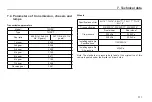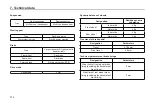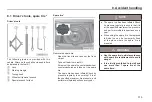
301
6. Operation and maintenance
-
Please note that the tread of winter tires
shall have patterns deep enough (tread
depth not less than 4 mm; otherwise, the
applicability in winter will be limited).
-
After installation of tires, check the tire
inflation pressure.
WARNING
● W i n t e r a n d s u m m e r t i r e s a r e
designed according to the typical
lane driving conditions under the
corresponding seasonal conditions.
It is recommended to use winter
tires in winter. At low temperatures,
the adaptability of summer tires is
significantly poorer, thereby losing
road adhesion and braking ability.
● If summer tires are used in severe
cold conditions, cracks may appear
on the tires, thereby completely
damaging the tires, and causing
excessive tire noise and loss of
balance.
WARNING
● After using winter tires, there may
be decreased driving traction on
dry roads, increased road noise
and shortened tread life. Please
pay attention to the performance
change of the vehicle in terms of
maneuvering and braking after the
winter tires are used.
● Please note that the maximum speed
for winter tires is relatively low. Do
not exceed the allowable maximum
speed for the tires.
● Please note that please replace the
winter tires with summer tires in
time in order to ensure driving safety
and performance when driving in
the environment at the atmospheric
temperature rising above 7°C
● When driving with winter tires, if
a spare tire is installed, unstable
steering characteristics may occur
due to different tires, weakening
driving stability. In this case, driving
styles need to be adjusted and
driving shall be performed carefully.
Inspecting tire pressure
The standard tire pressure data label of the
original tire of this vehicle is attached to the B
pillar on the driver’s side.
-
Check the tire pressure applicable to the
vehicle from the data label (the listed
pressure applies to both summer and
winter tires).
-
Unscrew the valve cap (if the valve cap is
missing, a new one shall be provided in
time).
-
A high-quality tire pressure gauge is
required to check the tire pressure. It is
impossible to determine whether the tire
pressure is appropriate only by visual
inspection.
-
Attach the tire pressure gauge to the
valve.
Summary of Contents for EMPOW
Page 350: ...344 9 Environmental protection information...
Page 356: ...VI Index...
















































